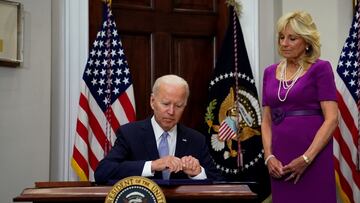Will the recently passed Bipartisan Safer Communities Act help limit access to guns?
US President Joe Biden signed the first significant federal gun control reform since 1994 into law Saturday, saying: “God willing, it’s going to save a lot of lives.”

US President Joe Biden on Saturday put pen to paper on the most significant gun control reform at federal level in the states since 1994 when he signed the Bipartisan Safer Communities Act into law in the Roosevelt Room at the White House with his wife, Jill, by his side. “God willing, it’s going to save a lot of lives,” the Democratic president said of the bill, which garnered enough support from Senate Republicans, including minority leader Mitch Mitchell, to pass. When it reached the floor of the House, 14 Republicans sided with Democrats to usher the bill through in a 234-193 vote.
Biden: “This is a monumental day”
“At this time when it seems impossible to get anything done in Washington, we are doing something consequential: If we can reach compromise on guns, we ought to be able to reach compromise on other critical issues,” Biden said. “I know there’s much more work to do, and I’m never going to give up. But this is a monumental day.”
The Bipartisan Safer Communities Act was tabled after the latest spate of mass shootings in the US. On 14 May, 10 shoppers were killed and three more people wounded in a massacre at a Tops Friendly Markets store in Buffalo. Ten days later, 19 schoolchildren and two teachers were killed at Robb Elementary School in Uvalde, Texas, and a further 17 people wounded. Both atrocities were carried out by 18-year-old males armed with AR-15 style assault rifles.
In response to these attacks, the Bipartisan Safer Communities Act includes longer background checks for under-21s seeking to but these kinds of weapons, as well as permitting vendors access to information on significant juvenile crimes, which was previously not the case. However, the law fell well short of banning access to assault weapons and high-capacity magazines among the 18-21 age group, as Democrats had sought in the original proposal. The Public Safety and Recreational Firearms Use Protection Act, a subsection of the Violent Crime Control and Law Enforcement Act, was signed into law by Bill Clinton in September, 1994, and imposed a 10-year ban on the sale of assault weapons manufactured after that date, as well as high-capacity magazines.
However, all other attempts to enact significant gun control legislation at federal level have failed to bear fruit, even in the wake of the 2012 Sandy Hook Elementary School massacre in which 20 six- to seven-year-old children and six adult staff members were killed by 20-year-old Adam Lanza. The so-called sunset clause in the federal ban on assault weapons kicked in after the 10-year moratorium in September, 2004, allowing more or less unlimited access to semi-automatic assault weapons for over 18s again.
What does the new gun control in the US include?
The new bill includes provisions to block gun sales to those convicted of abusing unmarried intimate partners, in a reversal of the so-called “boyfriend loophole,” and cracks down on gun sales to purchasers convicted of domestic violence. It also bumps up federal spending on school safety and mental health programs for young people, which pro-gun rights Republican and Second Amendment lobbyists have long argued are more at the root of mass shootings in the US than the right to bear arms itself.
The Bipartisan Safer Communities Act also provides $750 million in federal funding to states that administer “red flag” laws intended to remove guns from people deemed dangerous to themselves and others. These laws allow police, relatives or other concerned citizens to approach the courts for an order to confiscate guns and prevent the purchase of firearms by people deemed high risk: 19 US states and Washington, DC, currently have red flag laws in place.





